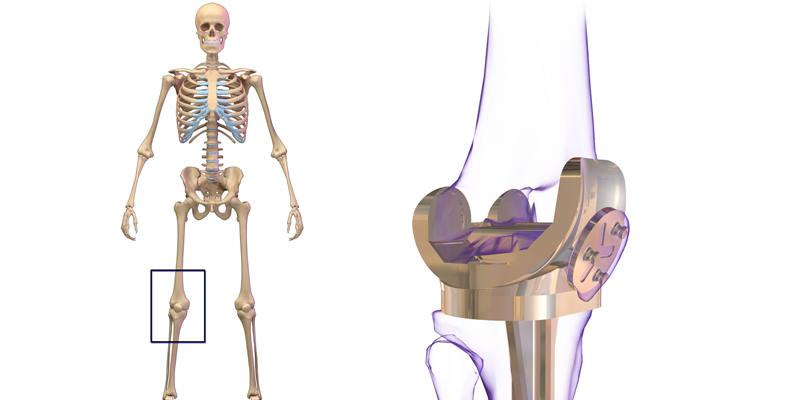By Alyssa Ciceron, SPT
What is a Total Knee Replacement (TKR)?
A total knee replacement (TKR) is a surgical procedure where the knee joint is replaced by artificial material.
Compared to other joints of the human body, the knee is the most commonly replaced joint. The knee is a hinge joint and motion occurs at the point where the thigh bone (femur) meets the lower leg (tibia). During this procedure a metal cap is placed on the end of the femur and a plastic cap placed on the top of the shinbone. Sometimes, a plastic insert is used to replace the kneecap.
What patients should consider a TKR?
The decision to undergo a knee replacement surgery should be discussed with your orthopedic surgeon and your physical therapist. Often knee replacement surgery is indicated when:
A. The knee joint has been damaged by degenerative diseases such as osteoarthritis or rheumatoid arthritis and trauma
B. Progressive knee pain and stiffness that causes problems with mobility and daily functions.
Exercising before surgery
It is extremely important to start an exercise program before a total knee replacement. Being in better physical shape prior to a TKR surgery will lead to better results after surgery and a faster recovery time. Various studies over the years have found that patients who are scheduled for a total knee replacement, and participate in a preoperative rehabilitation program, have better outcomes with functional mobility post operation.
In a 2006 study titled “Effect of preoperative exercise on measures of functional status in men and women undergoing total hip and knee arthroplasty”, the authors evaluated the short-term effects of a preoperative rehabilitation program on pain, functional status, and muscle strength. One hundred and eight men and women agreed to participate in the study. The results revealed that those individuals who participated in a preoperative exercise regimen were significantly less likely to attend an inpatient rehabilitation program post-op compared with those individuals who did not take part in an exercise program before surgery.
Pre-Operative Knee Replacement Exercises
Below are ten exercises we commonly instruct our patients to perform prior to surgery. You should be able to complete these exercises within 20 minutes and you should try to perform each exercise twice a day. In addition to these lower leg exercises, we do also recommend some upper body exercises. It is extremely important to strengthen the entire body before surgery not just the lower extremity because you will be relying on your upper extremity post surgery for activities like: Getting out of lying and sitting positions, walking and performing postoperative exercises.
Always remember to:
- Breath during each exercise
- Perform all exercises slowly
- Stop any exercise that causes excessive pain
Range of motion and strengthening exercises:
1). Ankle pumps
With legs relaxed, flex left foot up towards your head and than point left foot down towards the floor. Perform 3 sets of 10, than repeat with right foot.
2). Gluteal sets
While lying on your back, squeeze buttocks together. You should feel a muscle contraction in this area. Hold for 5 seconds than relax. Perform 3 sets of 10
3). Quad sets
With both legs relaxed, press both knees into the mat. You should feel muscle tightening in the front of the thigh, hold for 5 seconds and than relax. Perform 3 sets of 10
4) Hip Abduction and Adduction
While lying on your back slide one leg in and out. Make sure to keep your knee straight and your toe pointing up towards the ceiling. Repeat on other side. Perform 3 sets of 10.
5) Heel Slides
While sitting, slide your right heel towards your buttock, than slide your right heel down in the opposite direction. Repeat on left side. Perform 3 sets of 10.
6). Short arc quads
While lying on your back, place a towel roll underneath your right knee. Lift your right foot while keeping your knee straight. Make sure to keep thigh on towel roll. Repeat on left side. Perform 3 sets of 10
7). Long arc quads
Sit with back against chair. Straighten your right knee as much as possible. Hold for 5 seconds and than slowly allow right leg to come back down. Repeat using left leg. Perform 3 sets of 10
8) Armchair push ups
This exercise will help strengthen your arms for walking with crutches or a walker following surgery. Sit in an armchair. Place hands on armrests. Straighten arms, raising bottom up off chair seat if possible. Feet should be flat on floor. Perform 3 sets of 10
9). Hamstring stretch
While lying on your back, grasp underneath right knee and pull it towards your chest The straighter you can keep your leg the better stretch you will get. Hold for 30 seconds. Repeat with left leg.
10). Straight leg raise
While lying on your back, bend right knee. Lift left leg up to knee level. Keep knee straight and toes pointed up. Perform 3 sets of 10
For more information on how a physical therapy program can help before a total knee replacement, to get help with knee or hip pain, or to make an appointment for an evaluation or treatment, contact us at one of our two physical therapy clinics in Malta and Queensbury NY.






